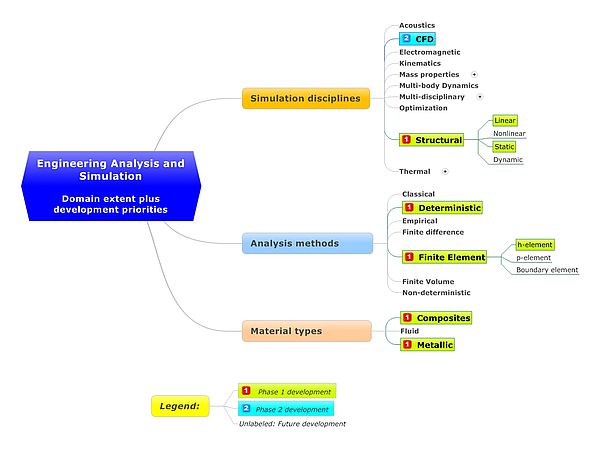LOTAR EAS: Engineering Analysis & Simulation Workgroup
This webpage introduces the reader to the Engineering Analysis and Simulation Workgroup (EAS WG) launched December 2014. The EAS WG is developing capabilities for archiving, retrieval and reuse of valuable engineering simulation and analysis assets. The information below describes:
- scope of the activity
- initial focus area
- associated use cases and test cases
- timeframe for development
Note: The LOTAR EAS WG is currently inactive. A relaunch of this domain is in preparation in accordance with industry requirements and priorities.
Goals and Objectives
The objective of the workgroup is to develop, publish and maintain standards-based mechanisms for archiving and retrieval of Engineering Analysis and Simulation information that can be read and reused throughout the product lifecycle, independent of changes in the Information Technology (IT) application environment originally used for creation.
The focus is on the long term preservation of the engineering analysis and simulation inputs, results and metadata for the design, manufacturing and support of aerospace products.
Figure 1 describes the broad engineering and analysis domain in scope of the development activity. The two areas to be addressed in the initial phases are depicted in the figure. The foundation laid in these phases will form a strong base for continuing development to address additional disciplines and data types in future years:
Figure 1: Engineering Analysis and Simulation Domain Initial scope
Business requirements and use cases
The LOTAR capabilities are being developed to address use cases driven by business needs expressed by stakeholders such as regulatory bodies, corporate policies, and contractual requirements, and needs commonly encountered in the regular process of engineering products and providing customer support.
These include legal items such as:
- product liability
- product certification
- incident investigations
and business items such as:
- enable long term access to engineering data for addressing customer queries
- evaluate new operating conditions and mission requirements
- modify existing products
- develop derivatives of existing products
- evaluate damage that might have occurred to a product
- knowledge capture.
Phase 1 will address the following use cases, which cover linear quasi-static finite element analysis of a vehicle level model. Other levels of details and types of analysis will be covered in subsequent phases.
| # | Name | Status |
|---|---|---|
| 1 | Long term archiving and retrieval of FEA model data and internal load results required for analysis of structural repairs | Draft |
| 2 | Long term archiving and retrieval of FEA model data and results to support modification of a vehicle | Draft |
| 3 | Long term archiving and retrieval of FEA model data and results to support development studies of a new vehicle design | Draft |
These use cases are drivers for creation of representative test cases illustrating the essential information of a long term archive of engineering analysis and simulation data.
LOTAR 6xx standards for Engineering Analysis & Simulation
The planned initial NAS / EN 9300-6xx standards for the Long Term Archiving of engineering analysis and simulation Information (Phase 1) will be organized into the following family of Parts:
| Part | Title | Planned ballot date |
|---|---|---|
| 600 | Fundamentals and Concepts for long term archiving and retrieval of engineering analysis and simulation | to be determined |
| 610 | Long term archiving and retrieval of Simulation Process and Data Management (SPDM) information | to be determined |
| 620 | Long term archiving and retrieval of Structural Finite Elemente Analysis information | to be determined |
The relationship of the NAS/EN 9300-6xx parts to each other is represented in Figure 2.
Figure 2: Structure and content of the LOTAR Parts 6XX
Associated ISO 10303 Information Models
- LOTAR standards do not define specific information models. They rely closely on the ISO 10303 Application Protocols, based on the modular architecture, which ensures the consistency of the information models subsets, common to several ISO 10303 standards.
- The LOTAR P6xx family is based on:
- The ISO STEP AP209 Ed.2 “Multidisciplinary analysis and design”.
Way of Working – Meetings and Teleconferences
- Due to ongoing reorganizations in the participating companies in the wake of Covid-19, this workgroup is currently on hold. A restart of the activities is planned for the second half of 2020.
- Conduct specific working sessions of the Engineering Analysis & Simulation WG during the quarterly LOTAR Workshops
Related Standardization Projects and Organizations
- ISO STEP AP209 Ed.2 “Multi-disciplinary analysis and design”: www.ap209.org
- Dedicated to the exchange, archive and reuse of configuration managed CAD, FEA and CFD data
- Released Dec. 2014
- ISO STEP AP235 Ed.1 “Engineering properties for product design and verification”: www.ap235.org
- To represent engineering property data that are used for product design and product validation
- Ed.1 released in 2009
- Ed.2 under way under the new name “Engineering properties and materials information”
- ISO STEP AP242 “Managed Model-based 3D Engineering”: www.ap242.org
- Provides modules used in AP209 Ed.2
- Active project open for evolution (development of AP242 Ed.2)
- CAE Interoperability Forum: www.mbx-if.de
- Dedicated to the implementation and testing of the STEP AP209 standard
- Runs CAE interoperability test rounds
- NAFEMS
- Simulation Data Management Workgroup (SDMWG)
- Memorandum of Understanding between LOTAR EAS and NAFEMS
- MoSSEC Project “Modeling and Simulation information in a collaborative Systems Engineering Context”: www.mossec.org/
- Overlap with LOTAR EAS activities to be investigated; ongoing project
- prostep ivip Association
- PSI 9 – C3I (“Simulation Data Management in Integrated Collaborative CAD / CAE Process Chains“
- PSI 4 – SimPDM (“Recommendation for the integration of simulation and computation in a PDM environment”)
- See the prostep ivip Medialibrary
Contacts
Please address your message to LOTAR-EAS-Contact(at)lists(dot)purdue(dot)edu if you would like more information about the team, workgroup activities and output, or to discuss participating in the workgroup. The team co-chairs are:
Workgroup Leader Europe
To be nominated
Workgroup Leader Americas
To be nominated


